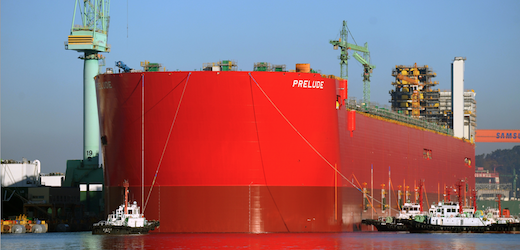
The 488-metre-long hull of Shell’s Prelude floating liquefied natural gas (FLNG) facility has been floated out of the dry dock at the Samsung Heavy Industries (SHI) yard in Geoje, South Korea, where the facility is currently under construction. Once complete, Prelude FLNG will be the largest floating facility ever built. It will unlock new energy resources offshore and produce approximately 3.6 million tonnes of liquefied natural gas (LNG) per annum to meet growing demand.
“Making FLNG a reality is no simple feat,” said Matthias Bichsel, Shell Projects & Technology Director. “A project of this complexity – both in size and ingenuity – harnesses the best of engineering, design, manufacturing and supply chain expertise from around the world. Getting to this stage of construction, given that we only cut the first steel a year ago, is down to the expert team we have ensuring that the project’s critical dimensions of safety, quality, cost and schedule are delivered.”
FLNG will allow Shell to produce natural gas at sea, turn it into liquefied natural gas and then transfer it directly to the ships that will transport it to customers. It will enable the development of gas resources ranging from clusters of smaller more remote fields to potentially larger fields via multiple facilities where, for a range of reasons, an onshore development is not viable. This can mean faster, cheaper, more flexible development and deployment strategies for resources that were previously uneconomic, or constrained by technical or other risks.
Prelude FLNG is the first deployment of Shell’s FLNG technology and will operate in a remote basin around 475 kilometres north-east of Broome, Western Australia for around 25 years. The facility will remain onsite during all weather events, having been designed to withstand a category 5 cyclone.
Shell is the operator of Prelude FLNG in joint venture with INPEX (17.5%), KOGAS (10%) and OPIC (5%), working with long-term strategic partners Technip and Samsung Heavy Industries (the Technip Samsung Consortium).
About Prelude
• Prelude is expected to produce 3.6 million tonnes per annum (mtpa) of LNG, 1.3 mtpa of condensate and 0.4 mtpa of LPG, and to remain on location for approximately 25 years.
• The Prelude FLNG hull is longer than four soccer fields laid end to end and it is longer than the Empire State Building is tall.
• The LNG storage tanks have a capacity equivalent to approximately 175 Olympic swimming pools.
• Once complete, the FLNG facility will weigh more than 600,000 tonnes fully loaded, displacing the same amount of water as six of the world’s largest aircraft carriers.
• Whilst the Prelude facility is big it is also small – taking up 1/4 the area of an equivalent onshore LNG plant.
• Existing technology that has been adapted for FLNG includes:
* Close coupling between the producing wells and the LNG processing facility – This is the physically short length from one to the other
* Mooring systems – making it bigger for the largest floating facility ever built and dealing with the associated forces.
o The marinisation of processing equipment, so that it will work on a floating facility.
* Water intake risers, as water will be used as part of the cooling process needed to turn the gas into LNG.
* LNG tanks that can handle sloshing – that is the motions of the liquid LNG within the hull if and when there are stormy seas.
* LNG offloading arms which will transfer LNG from the facility to the ships moored alongside – two moving facilities instead of just one.
• On 2 September 2013, Woodside announced the use of Shell FLNG technology as the development concept to progress through the Basis of Design (BOD) phase to commercialise the Browse gas fields.
Source: www.shell.com

